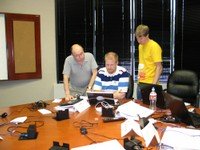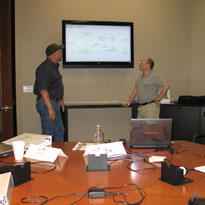What I did on World IPv6 Day
Thursday, June 8th, 2011 was the Internet Society’s World IPv6 Day. Years from now will you remember where you were and what you were doing on this important day? While the events of World IPv6 Day are not etched as deeply into my memory as, say, the day Ronald Reagan was shot or the day terrorists flew airplanes into the World Trade Center, it is every bit as memorable as Y2K and a day I will long remember. But, the story begins sometime earlier.

Weeks before World IPv6 Day Eogogics was contacted by Dewayne King, the Vice President of Operations for ICTX WaveMedia in Houston, Texas to conduct a four day IPv4 to IPv6 Migration Workshop. In many ways, Dewayne is the perfect Vice President of Operations. He is respected and trusted by his management, but at the same time he is every bit a network engineer and tech, with rough good looks, the sun-ravaged skin of a man who spends a lot of his time outdoors and a confidence that can only come from having built the network pretty much from the ground up. While Dewayne refuses to accept the credit for developing a master plan and building his network to its exact specifications, at the very least he cannot refute the idea that the right decisions were made at each point along the way while building a network which many of his envious competitors may never be able to achieve. The results are that ICTX WaveMedia has a network which is as simple and easy to maintain as possible and accommodates all types and flavors of customer traffic while giving the customers the capacity they need at a competitive price.
Over the course of several weeks, Eogogics developed a custom workshop to meet ICTX WaveMedia’s training objectives. Dewayne had several objectives for the training, all of which are related to the requirement to keep his staff as prepared as possible to meet customer needs. Specific training objectives were:
- Make Dewayne’s people capable of looking at the ICTX network from an IPv6 perspective
- Be certain ICTX is ready to assist their customers across the IPv4 to IPv6 bridge
- Have internal familiarity with IPv6
- Establish a common and accurate vocabulary for use internally and with customers
- Write a draft plan for migration of their ISP backbone to IPv6
Meet the Attendees
 The workshop was attended by six ICTX WaveMedia personnel of which three are network engineers, two are NOC technicians, and one is network engineering manager. Everyone is very skilled in their particular areas and each brought something special to the workshop. This is very important because a workshop is not a “class”, per se, or a video that is played to eager viewers. Rather, a workshop is a collaborative environment that is facilitated by the person standing up and that person is not always the “instructor”, in the traditional sense. All of the attendees made excellent and timely contributions and I think that each, in their own ways, benefitted a great deal from the workshop if their comments during the daily end-of-day debriefs were any indication.
The workshop was attended by six ICTX WaveMedia personnel of which three are network engineers, two are NOC technicians, and one is network engineering manager. Everyone is very skilled in their particular areas and each brought something special to the workshop. This is very important because a workshop is not a “class”, per se, or a video that is played to eager viewers. Rather, a workshop is a collaborative environment that is facilitated by the person standing up and that person is not always the “instructor”, in the traditional sense. All of the attendees made excellent and timely contributions and I think that each, in their own ways, benefitted a great deal from the workshop if their comments during the daily end-of-day debriefs were any indication.
Building on IPv4 and Big Bandwidth vs Managed Bandwidth
ICTX WaveMedia has massive fiber capacity which gives them a clear competitive advantage and allows them to easily accommodate growth of existing customers and addition of new customers. With a network running around 4% full ICTX WaveMedia can ignore the complexities of traffic management and Quality of Service and the costs and performance issues that go with them. Starting with this architecture as a base, the first day of the workshop traversed the 7-Layer OSI Model from bottom to top and established a sound, common understanding of IPV4 and the architectural components and services that ICTX customers are using today. The WireShark protocol analyzer was introduced as a tool for use in the class as well as a skill that could be applied to installation and troubleshooting scenarios after class. Drills were done where each workshop participant lead the group through the intricacies of all seven layers of packets captured dynamically during class. This is the scariest thing for anyone who is just an instructor – as opposed to a practitioner – because anything can show up on the screen and a run-of-the-mill instructor will be left without a script. Not everything in our dynamic WireShark captures was vanilla, either, and we worked through all of the fields of several dynamic traces together to develop an understanding of exactly what we were seeing. And, on World IPv6 Day itself we were not disappointed: there was an increase in IPv6 traffic, both tunneled and native mode that we were able to view as well, but, I am getting ahead of myself.

It wouldn’t be fair to leave the reader with the impression that we taught a bunch of novices IPv4 from “zero to hero” on Day 1 of the workshop. What we actually did was to fill in gaps in knowledge, establish a common vocabulary on everything from bytes to octets to the way that they are numbered to a common understanding of PING and TRACEROUTE and similar functions. With Day 1 behind us, and a solid common understanding of IPv4 as a foundation we moved on to IPv6 issues and migration strategies, which is where we concentrated our efforts for Day 2 and Day 3. We discussed various functions, such as DNS, DHCP and ICMP which exist in IPv4 and still exist in IPv6 as well as NAT and broadcast addresses which no longer exist in IPv6.
One aspect of the class which was not a prominent element of the original workshop plan was security. We discussed security at each step and made it a dimension of every aspect of the architecture, design and planning process.
Customization On Top of Customization
During the daily debrief at the end of Day 3 – preparing to go into the last day of the workshop – attendees were polled and they identified three areas where they felt they needed more information. They wanted more depth on IPv6 addressing with more real life examples and more guidance about how they would deal with IPv6 addresses, they wanted to better understand the Regional Internet Registries and their relationship to them and the hierarchy of address assignments, and they wanted to fully understand how IPv4 addresses are embedded into IPv6 address and converted into hexadecimal. Additional content was prepared on these topics overnight, distributed to workshop attendees and the morning of Day 4 was spent going over the additional supplementary materials, asking and answering questions and rounding out the attendees understanding of IPv6 and the workshop leader’s understanding of the needs of ICTX WaveMedia prior to the final stage of the workshop: developing a customized migration plan for ICTX WaveMedia and their customers.
The Plan
While the specifics of the ICTX WaveMedia migration plan are proprietary and confidential, there are several elements of the plan which can be disclosed in abstract and can provide guidance to persons wishing to know more about the process.
- Because the ICTX WaveMedia network is a simple, flat, high capacity network, much of the work that ICTX will be doing is assisting their customers across the IPv4 to IPv6 bridge. There are several activities planned – from customer workshops and training to pre-migration testing – to assist ICTX WaveMedia and their customers to become educated and experienced and make a seamless transition.
- ICTX WaveMedia is doing the calculations prescribed within the IETF RFCs to determine how many IPv6 addresses they will be able to acquire and are taking steps to acquire the addresses before they are needed.
- ICTX WaveMedia will complete several network optimization and upgrade steps well before the time of migration to IPv6 to assure that they have a stable network before any migration step is begun.
- ICTX WaveMedia will establish an IPv6 test bed and exercise all aspects of migration and operation prior to migration.
- ICTX WaveMedia understands the value of the IPv4 addresses that will be freed up during the migration and will manage an IPv4 address pool to allow growth of the IPv4 network customers to keep them from being forced into a migration before they are ready.
- ICTX WaveMedia will provide their customers with several migration and transition mechanisms from which to choose but will provide guidance to their customers as to which are the most viable for their customers based upon the customers’ specific requirements.
Conclusion
Like another memorable day – Y2K – the transition to IPv6 will be orderly and without carnage and chaos, at least at ICTX WaveMedia, because of meticulous planning, staging, testing, education and execution of the plan when the time comes. Unlike Y2K there is no “drop dead” date, no clock striking midnight, but Dewayne King and ICTX WaveMedia management heard the news that the final available blocks of IPv4 addresses had been given out in February and were smart enough to plan rather than panic, to develop a clear way ahead before their customers forced them to and to become leaders rather than victims in the IPv4 to IPv6 transition. Whatever you were doing on World IPv6 Day I hope it was as memorable – and productive – as how I spent my time on that day.
Editor’s Note: Jim Cavanagh, who heads up our networking team, is leading the Eogogics effort to help our clients – old and new – to make smooth, logical and painless transitions to IPV6, something that is easily and seamlessly accomplished with proper planning and attention to detail. He is the developer of our action-learning workshops (workshop 1, workshop 2, full IP curriculum) that combine IP training with a day of hands-on IPv6 migration planning specific to the client’s own network. A dynamic and entertaining speaker, he has been involved in the application, architecture, implementation, security, and trouble-shooting of IP networks for 35 years. His IP involvement has covered every conceivable application including corporate, government, public safety/security, and law enforcement. He has been involved in global corporate and US government IPv6 planning and implementation initiatives since the late 1990’s with organizations that include leading Internet and Backbone Service Providers (BSPs/ISPs) and the DoJ, DoD and DHS since. He is a pioneer in VoIP and was the first to use the term “intranet” in his 1995 book, Internet and Internetworking Security, one of the six books (and scores of technical articles) he has published to date.


Sorry, comments for this entry are closed at this time.